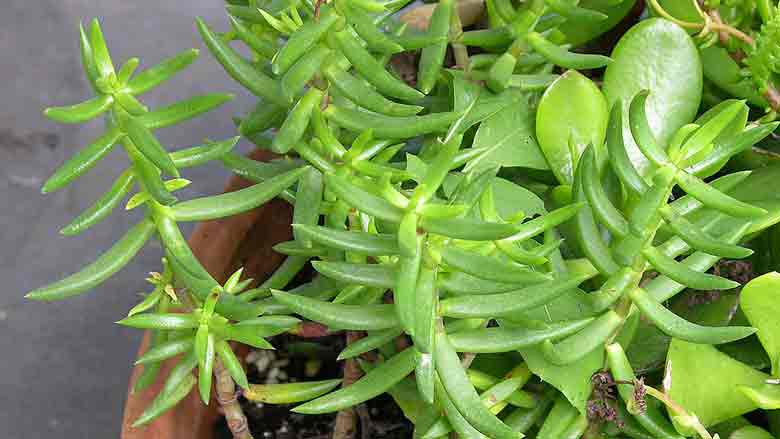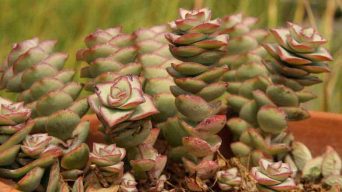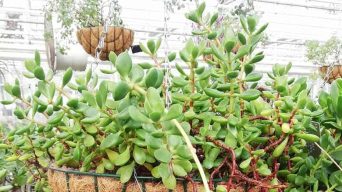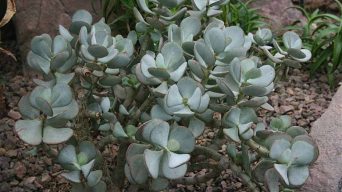If you are looking for a low-maintenance, drought-tolerant plant that is easy to propagate, then the Crassula Tetragona, also known as the Miniature Pine Tree, may be just what you need.
This guide will help with the care and propagation of this unique plant.
It includes steps on how to take care of it, water it properly, propagate new plants from cuttings or leaves, and avoid common mistakes when growing this type of plant.
How To Care for Crassula Tetragona ‘Mini Pine Tree’
A Miniature Pine Tree’ is a succulent plant that requires careful attention to maintain its health and beauty.
They are popular house plants due to how easy it is to care for them as long as they receive the proper amount of water and sunlight.
This guide will provide you with all the information needed.
Sun Exposure & Light Requirements
The Crassula Tetragona plant needs at least six hours of sun exposure each day. It can be grown in filtered light, so it is ideal for a shaded porch or patio without direct sunlight.
- Place the succulent where it will receive as much indirect daylight as possible and no more than four hours of full sunlight.
- Make sure the succulent receives at least six hours of indirect sunlight a day.
- The Crassula Tetragona can be grown indoors under fluorescence or grow lights with care and correct pruning techniques.
Place the succulent in an area with bright filtered sunlight for up to four hours, and then give it partial shade or more if you want to protect it from intense direct sunlight.
Remember that this is not just a matter of shading your window sills but keeping them shaded throughout all parts of the house where they receive daylight.
Watering
The best way to water the Crassula Tetragona succulent is by letting it dry out in between watering sessions.
If the soil becomes too wet, roots will rot, and leaves may develop fungus or turn brown from being constantly damp. The plant can also lose its natural resistance against disease when overwatered.
It is best to water the Crassula Tetragona succulent early in the day or late so that it will have time to drain.
The plant should absorb moisture from watering and not leave it on its foliage for too long.
The soil surface needs to dry out before more droplets penetrate below ground level (or else root rot may occur).
The quantity of water needed varies depending on how hot your climate is.
If you live in a tropical area where there are higher temperatures year-round, plants need less moisture than people living in areas with seasonal changes between winter and summer.
These two extremes also mean different things for what type of potting materials work best for various climates.
For example, Crassula succulents planted in the ground can tolerate drought conditions better than those grown in containers.
Soil
The Crassula Tetragona can grow in a wide range of soil types, but the best one would be cacti or succulent potting mix.
This is because they need to live in well-draining soil with minimal water retention.
However, suppose you have any doubts about your particular type of soil. In that case, it’s always better to go ahead and use succulent potting mix instead to make sure that there are no problems later on down the line.
In general, the soil should be porous and well-draining. If it is not, you will end up with a plant with rotting roots or stems due to excess water retention.
It’s important for this type of succulent plant since they must always live in very dry conditions.
An excellent way to know if your soil needs improvement would be by checking whether any parts are still wet even after being watered thoroughly.
We recommend using cacti mix potting soil instead of regular dirt/potting soil when propagating Crassula Tetragona from cuttings so that transplanting into pots does not kill the new growths.
However, it’s essential to note that the soil should still be well-draining.
Temperature and Humidity Requirements
The Crassula Tetragona ‘Mini Pine Tree’ succulent plant prefers a temperature range of between 15°C and 25°C. It will also do well in temperatures as high as 28°C.
Still, it should not be exposed to temperatures below 18°C for too long, even if the air is humidified.
The humidity requirements for this type of succulent are very low, with an average relative humidity of less than 50%.
If your Crassula plant does not seem to be growing well, you can increase the humidity levels around your plant. Place some pebbles on top or mist it daily with water from a spray bottle.
During the winter, the Miniature Pine Tree succulent plant should be kept in temperatures that are at least 18°C to prevent it from becoming too dry.
The temperature and humidity requirements for this type of succulent can vary depending on where you live, so make sure to check your local climate before making any adjustments.
Crassula tetragona care is not very complicated as long as the right conditions are provided.
Fertilizing
Fertilizing your succulent is necessary to make sure it stays healthy and beautiful.
It’s best to fertilize during the growing season, which for Crassula Tetragona ‘Mini Pine Tree’ plants starts in late spring (in zones where temperatures don’t drop below 40° Fahrenheit).
Fertilize your succulent using a balanced liquid fertilizer diluted to ¼ strength (half the recommended dosage).
Make sure that you water your plant thoroughly before fertilizing it.
You can use any kind of mild or indoor-safe, slow-release houseplant fertilizer for this purpose. Just make sure it’s not too high in nitrogen because Miniature Pine Tree plants prefer more potassium and phosphorous instead.
The frequency with which you should fertilize depends on how much light and water your Crassula Tetragona’ Mini Pine Tree’ receives and its age.
Start by giving young plants three feedings per year at half-strength every six weeks, and adjust accordingly as it ages.
Choosing the Right Container
Regarding container choice, it is crucial to remember that the Crassula Tetragona prefers bright indirect light and porous soil.
This means you’ll need an open pot with drainage holes on the bottom – try not to use clay pots, or at least ensure they have drainage holes.
Try using containers made from terracotta or wood instead!
Clay pots are heavy and will eventually dry out the plant if allowed to sit in water for too long.
Wood containers tend to be lighter, which allows more air circulation around your plants’ roots.
If you want a closed pot or one with sealed drainage, select either plastic (watch out for toxic fumes!) or glass vessels without any painted exterior.
The pot or container should be large enough to accommodate your plant’s root system.
In general, a good rule of thumb for this is about one inch in diameter per year after planting if you want a single-stemmed plant or two inches for plants with multiple stems.
Once your Crassula Tetragona has outgrown its pot, it’s time to get another that is larger and transfer your succulent from the original container into the new one.
Make sure not to unroot any of the existing roots when transferring.
It may take some trial and error, but eventually, you’ll find a pot size that works well for your situation. Keep an eye on how quickly they grow so you can plan accordingly!
Repotting Your Crassula Tetragona
Crassula tetragona plants should be repotted every two years or when the plant has outgrown its pot.
It is recommended to use a container that will fit with just one inch of soil depth so the succulent does not rot from too much water near its roots.
The best time to repot this particular variety of succulents is during the late winter and early spring months when its active growth period starts.
To remove the plant from its old pot, carefully lift it up and out on either side of the spine so as not to disturb any leaves.
Use a knife or sharp implement to free the roots from any attached potting mix.
Rinse off soil from leaves, then leave it on a well-lit surface for 24 hours before putting it in its new container so as not to shock the plant with too much light exposure after such an ordeal.
The bottom of your new planting container should be at least one inch larger than the top of your current pot.
This will provide room for healthy root growth and keep excess water away from them, which could cause rot or other fungal diseases.
If you are using a clay pot, make sure there are drainage holes in the bottom by poking some small ones through with something like an ice pick or screwdriver head.
Fill up about one-quarter of the way full with fresh potting mix, and then place your Crassula tetragona in.
Pruning
The Crassula Tetragona succulent is a slow grower and will not need significant pruning unless it becomes overgrown.
When you have to trim your Crassula, cut back the latest growth as close to where it joins with the older stems as possible.
You can also remove branches that are dead or diseased.
Remember this plant’s natural tendency for bushiness when deciding how much of each stem you should leave behind during any trimming session.
- Trim off leaves from bottom branches so they don’t get too shaded
- Remove old brown or damaged leaves
- Cut new shoots coming up at their base after flowering away near ground level
- Cut off or pinch back stems that have grown too long to maintain the overall shape of your plant
The branches will be a bit sharp when you first cut them but should eventually soften with time.
The most important thing is not to over-prune and therefore remove all new growth from this succulent.
Pests and Diseases
Many people believe that they can’t get pests and diseases on their Crassula Tetragona, but this isn’t true.
Pests
Not all succulents are created equally. Some varieties are more susceptible to bugs than others.
Suppose you have a high-end variety with thin leaves that is used for indoor growing. In that case, it’s likely going to be less resistant to pest invasion than other plants which grow in outdoor conditions.
While your indoor plant won’t come under attack from every type of bug out there, here are four types of pest infestations that could happen when you’re not vigilant:
Scale
Scale seems like one bug among many, but it’s a serious pest.
You’ll find them clustered on the stem or leaves of your succulents, and they’re difficult to remove because their waxy coating makes them slippery as well as icky.
Mealybugs
If you see little bugs that are white and fluffy with black spots all over their bodies feeding off your plant, then you have mealybugs.
These pests will suck the sap out of plants until there is nothing left for flowers or growths to support themselves in life!
Aphids
Aphids can be pesky when they start invading the roots of a Crassula Tetragona plant. This could stunt its ability to grow properly.
They also cause damage by sucking up plant sap and injecting a virus into the plant, which will stunt its growth.
Spider Mites
If you see webs all over your succulent’s leaves or stems, then it has spider mites!
These pests dig tiny tunnels in between plants with their mouths to suck up sap from below.
They also leave behind dusty footprints that show the path of destruction they’ve left on your prized plant.
Diseases
Some diseases you might encounter with your Crassula Tetragona plant are:
Leaf Spot
This disease is characterized by dark or black spots on the leaves that will eventually turn brown and yellow as they deteriorate.
Sometimes these can be large enough to cause a whole foliage section to fall off, but other than this, not much else happens.
This disease is caused by an opportunistic fungus called “Cercosporidium”.
The most common thing to do when treating this problem is to use fungicide spray. You may also use a systemic product like chloronitrofen to treat the soil.
Rots
Some plants, like those in the Crassula species, are susceptible to rotting due to their fleshy leaves and stems.
This means that you should make sure that it is not being watered from above because this can lead to rot which will be difficult for your plant to recover from if left unchecked.
Leaves Turning Brown or Yellowing
If a crassula has discolored leaves, there are many possible causes, including:
- Underwatering
- Cold drafts around window sills with succulents inside them (especially when they’re flowering)
- Insufficient lighting conditions, along with overwatering as well
Leaves Dropping Off
If you notice your Crassula’s leaves are dropping off, it could be several things, including but not limited to underwatering, which can lead to rot or overwatering, leading to too much moisture.
Dusty soil may also cause your plant’s leaves to fall off.
How To Propagate Crassula Tetragona ‘Mini Pine Tree’
Crassula tetragona can be propagated in 3 ways: seeds, leaf, and stem cuttings.
Stem Cuttings
One way is to take a cutting, which can be done from either the parent plant or its offspring.
- Select a healthy stem from the mother plant.
- Allow the cut to be callous over for 24 hours before planting it into the soil mix. The best time to take this type of cutting is when plants are in active growth during the late spring and summer months (wintertime doesn’t allow enough light).
- Use clean, sharp shears or a knife to make a diagonal slice from the edge up toward the top of the plant’s leaves. Leaves will help in creating new roots once it starts growing again.
- Dust the cut with rooting powder and place the stem into a container filled with soil mix.
- Water once per week and keep it at room temperature.
- Keep it in bright indirect light, do not expose it to direct sunlight, as this can fry the plant.
After about six weeks, new roots will start growing from the bottom of the cutting.
When you see around one inch high of root tips, it is time to transplant (the pot should be no more than an inch deep). Make sure that when planting, there’s enough space in between for growth!
This may take up to two years, depending on how long your desired rooted height is.
Leaf Cuttings
The second option is to use leaf cuttings.
These are typically used in warmer climates with more intense sunlight because they need a lot of light for leaves to grow new shoots that will eventually turn into roots.
To start using leaf cuttings, you should remove two leaves from the stem near the ground.
Be careful not to damage any other parts of this plant. These sections might also produce new plants.
- Cut the leaves into three to four-inch sections and then place them on a well-draining soil mix.
- Do not water for at least two weeks until new shoots appear from each leaf cutting site. Once this happens, lightly misting your plants with water every few days is okay.
It will take six months to one year before roots form enough of an attachment to be removed from the potting medium.
But if conditions are right, you should see visible growth within as few as two months.
Seeds
Crassula tetragona can also be propagated from seeds.
Sow the seeds in a well-draining planting mix and irrigate gently with water to moisten the soil. Place into indirect light for best results.
Seeds should germinate within two weeks, but it could take up to three months before they sprout if conditions are not favorable enough.
You will know when a seed has sprouted because you will see green leaves that resemble cacti starting to grow out of them.
It means that your plant has started growing roots already, so don’t worry about it too much.
Once your plants have grown several inches tall, pot up individually or in groups of two or three to a large pot with cacti and succulent soil.
Final Thoughts
The Crassula tetragona ‘Mini Pine Tree’ is a great plant for succulent enthusiasts looking to add variety and color to their collection.
The care requirements of this plant make it very beginner-friendly.
Still, the best thing about this type of succulent is that no special care is needed at all, making it an excellent plant for the busy succulent gardener.







